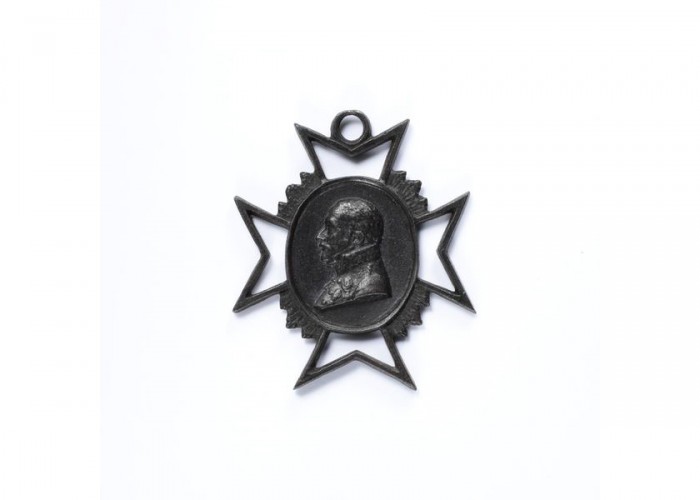Berlin Iron Cross
This Iron Cross was awarded to soldiers of the Prussian army who had distinguished themselves in battle. At the time of the Battle of Waterloo, the German states were in desperate need of money to finance their wars against France, and it became popular to make jewellery and medals out of cast iron rather than gold or silver.
This Iron Cross was designed and made by Karl Friedrich Schinkel around 1813 and produced in Berlin. It was unusual for its time because it was made of an inexpensive material (iron) and was awarded to officers and men alike, regardless of social status. Large numbers of Prussian soldiers fought in the Allied armies that defeated Napoleon at Waterloo, in 1815.
Cast-iron jewellery developed into a fashionable novelty in Europe, particularly in the German states where it became a symbol of Prussian patriotism. Not only was it used to make this Iron Cross awarded to soldiers, but iron jewellery was given out in recognition of other deeds which helped in the war effort to defeat Napoleon. An example of this was iron inscribed with ‘I gave gold for iron’ that was given to women in Prussia in exchange for the gold jewellery which they donated to their country. This is symbolic of the spirit of the German states and their determination to defeat Napoleon and the French.
During the Napoleonic period, Germany did not exist as one country as it does today. Instead it was made up of many small German states, Prussia being the largest and most dominant. The different states worked together to bring about victory over France, their common enemy. The Napoleonic Wars were crucial to the process of unifying Germany into the single nation that it later became. At the Battle of Waterloo, a large proportion of the Allied army was German, and when the Prussian army, which arrived late in the battle, is taken into consideration it is clear that the German states played a crucial role in the allied victory over Napoleon.
-
Curatorial info
- Originating Museum: Victoria & Albert Museum
- Accession Number: M.278-1928
- Production Date: 1813
- Material: Cast iron
- Creation Place: Germany
- Size: Height: 3.5 cm, Width: 3.1 cm, Depth: 0.2 cm
-
Use this image
You can download a higher resolution image below, but please note the conditions of the licence.
- Rights Holder: Victoria and Albert Museum
- License Type: All Rights Reserved
Find it here
This object is in the collection of Victoria and Albert Museum









